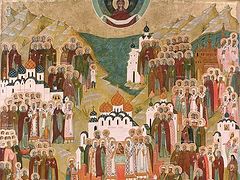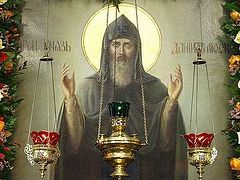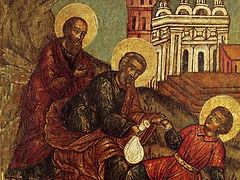The story of the very first Russian holy martyrs who shed their blood for Christ begins back in apostolic times when the holy Apostle Andrew the First-Called came to baptize our ancestors, preaching eternal salvation. These holy martyrs are Inna, Pinna and Rimma. They are commemorated by the Russian Orthodox Church on January 20 / February 2 and June 20 / July 3.
 Sts. Euthymius the Great, Martyrs Inna, Pimma and Rimma (January 20th). The Menologion of Byzantium. Greece; Fourteenth century According to St. Dimitry of Rostov who compiled the famous Lives of the Saints, on the hills of Kiev the Apostle Andrew, addressing his disciples, said: “Believe me that the grace of God will shine on these hills; a great city will be here, and the Lord will erect many churches there and enlighten the whole of the Russian land with Holy Baptism.”1
Sts. Euthymius the Great, Martyrs Inna, Pimma and Rimma (January 20th). The Menologion of Byzantium. Greece; Fourteenth century According to St. Dimitry of Rostov who compiled the famous Lives of the Saints, on the hills of Kiev the Apostle Andrew, addressing his disciples, said: “Believe me that the grace of God will shine on these hills; a great city will be here, and the Lord will erect many churches there and enlighten the whole of the Russian land with Holy Baptism.”1
The first Russian holy martyrs Inna, Pinna and Rimma (the first century) were disciples of the holy Apostle Andrew. They were originally from the northern land of Great Scythia—that is, they were Ilmen Slavs.2
In the book by Archbishop Sergius (Spassky; 1830-1904), The Complete Menologion of the East, Scythia Minor is mistakenly referred to as their homeland. “The Roman and early Byzantine province of Scythia Minor (the region of modern Dobruja, Romania) did not appear until the late third and the early fourth century AD under Emperor Diocletian.”3 Therefore, it was impossible for them to have been disciples of the Apostle Andrew and residents of Scythia Minor at the same time, a fact that Archbishop Sergius did not pay attention to.4
Sts. Inna, Pinna and Rimma were baptized by the Apostle Andrew, ordained priests and sent to strengthen faith and establish piety among the Greeks and foreigners living in the Bosporan Kingdom. On the way to Tavria, they preached the Christian faith and baptized people everywhere.
By order of a pagan Prince of the Chersonese they were captured and subjected to a terrible execution for preaching the Christian faith. In the hagiographic tradition of the Western Church, there is evidence in Asta Sanctorum by Jacobus de Varagine5 about their martyrdom:
“De Sanctis Martyribus Inna, Pinna, Rimma.
“Non sit calidum et splendidus sicut crystallus Inna refrigerandi vim habet ad fortes illius, Pinnensem Rima. Et in agonibus martyrum, quaedam prouinciae conuenerunt, et idolis servientes, quo capta barbaros ad praesidem. Christus praecepit ut a frigus Confessoris. Martyr accideret structum solidus acta in medio aquarum: et quamvis per ventosa frigoribus et corpus aquae gelu constricti et sedebam tristis usque peruenit ultimum vita, operam ad eorum beatitudinis rutsi anima Dei.”
“May the strugglers with cold Inna, Pinna and Rimma, who are as pure as crystals, find warmth. They suffered martyrdom in some northern province, where they were seized by barbarian idolaters and brought before the ruler. He commanded that the confessors of Christ perish from the cold. The martyrs were tied to straight and hard logs set in the middle of a stream, and although it was a windy and cold season and the surface of the water was frozen hard with frost, they remained motionless until they reached the limit of their earthly lives, commending their blessed souls into the hands of God.”6
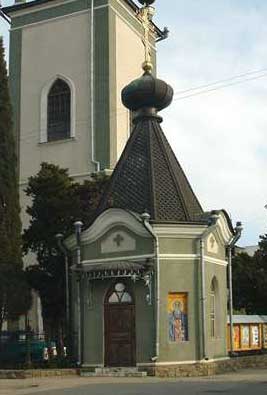 The Chapel of Sts. Inna, Pinna and Rimma in Alushta Thus, the saints gave up their righteous souls to God, preserving the deposit of faith and love for our Lord and Savior Jesus Christ, glorifying Him by their martyrdom. Christians secretly buried the bodies of the saints of God. When a favorable time came for Christians in the city, Bishop Gedtsa, who was in charge of the local diocese, found their holy relics and enshrined them in the city’s cathedral church. Seven years later, the martyrs appeared to the bishop and ordered him to translate their holy relics to a “port”—a place called Alix (now Alushta). “The original text of the manuscript of the Martyrdom (probably the second half of the fourth century) has not survived; an eleventh century manuscript (Paris. Gr. 1488) contains a brief extract from it (an epitome); legends are also known in Byzantine synaxaries in verse from the late tenth to the thirteenth centuries (see, for example: SynCP. Col. 407; Paris. Gr. 1617; Ambros. B. 104) <...> The title of the epitome indicates that Sts. Inna, Pinna and Rimma suffered in Gothia (in the Menologion of Emperor Basil II (the late tenth to the early eleventh century) an archaic name is used—Scythia. <...> Professor Yevgeny Golubinsky (1834-1912) suggested that Inna, Pinna and Rimma suffered in the Crimea, and their relics were transferred to the port of Alisk, or Alix, situated in what is now Alushta.”7
The Chapel of Sts. Inna, Pinna and Rimma in Alushta Thus, the saints gave up their righteous souls to God, preserving the deposit of faith and love for our Lord and Savior Jesus Christ, glorifying Him by their martyrdom. Christians secretly buried the bodies of the saints of God. When a favorable time came for Christians in the city, Bishop Gedtsa, who was in charge of the local diocese, found their holy relics and enshrined them in the city’s cathedral church. Seven years later, the martyrs appeared to the bishop and ordered him to translate their holy relics to a “port”—a place called Alix (now Alushta). “The original text of the manuscript of the Martyrdom (probably the second half of the fourth century) has not survived; an eleventh century manuscript (Paris. Gr. 1488) contains a brief extract from it (an epitome); legends are also known in Byzantine synaxaries in verse from the late tenth to the thirteenth centuries (see, for example: SynCP. Col. 407; Paris. Gr. 1617; Ambros. B. 104) <...> The title of the epitome indicates that Sts. Inna, Pinna and Rimma suffered in Gothia (in the Menologion of Emperor Basil II (the late tenth to the early eleventh century) an archaic name is used—Scythia. <...> Professor Yevgeny Golubinsky (1834-1912) suggested that Inna, Pinna and Rimma suffered in the Crimea, and their relics were transferred to the port of Alisk, or Alix, situated in what is now Alushta.”7
It can be assumed that the holy Martyrs Inna, Pinna and Rimma had the rank of bishops, since the kontakion (hymn) dedicated to them reads: “...Intercessors of Christians, heralds of the Kingdom of Heaven”, and such a comparison is applicable only to bishops. “Rejoice, O Holy Inna, Pinna and Rimma, Passion-bearers of Christ and the first Baptizers (!) and Heavenly Intercessors of the Russian Land8…”
In the Complete Menologion of the East, Archbishop Sergius (Spassky) cites information from the Serbian prologue of the thirteenth century, where in the instruction on the feast of the holy Russian martyrs their names are given in Serbian letters: Jenen, Nirin and Pen9.
Among the Russian saints of the first century the historian Vasily Tatishchev (1686-1750) names the unjustifiably forgotten martyred Prince Oskold (Askold) and Gleb (Uleb), Svyatoslav's brother. He wrote: “He (Oskold) can be venerated as the first martyr of Russia, along with Uleb (Gleb), Svyatoslav’s brother, who, out of ignorance of history, are forgotten and not included in the Church calendar.”10
Some hieromartyrs of the Chersonese are also known among the first Russian saints: Bishops Basil, Ephraim, Eugene, Agafador, Elpidius, Etherius, Kapiton, the holy Martyr Emilian, the holy Great-Martyr Nicetas the Goth (†305), and the holy Martyr Florian Stratilates (†300).
These are only some of the famous first Russian saints glorified by the Orthodox Church universally. And how much information about other Slavic-Russian saints has been lost! The chronicles, which contained so much valuable information about the lives of our distant ancestors, were destroyed by fire during the invasions of foreigners: the Goths, the Huns, the Khazars and others.
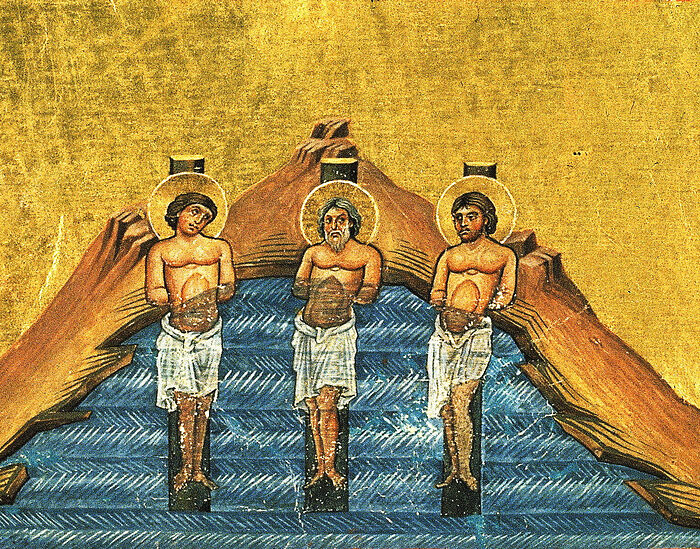 A Miniature from the Menologion of Basil II
A Miniature from the Menologion of Basil II
In the archives of Simferopol, a document entitled “To All the Priests of the Simferopol and Crimean Diocese” has been preserved. It says, “I ask you, all-honorable fathers, to commemorate the holy Martyrs Inna, Pinna and Rimma at the dismissal of the Liturgy, Vespers and Matins, for they should be considered Crimean saints. These are very early martyrs.” This document was signed on October 30, 1950 by St. Luke (Voyno-Yasenetsky), Archbishop of Simferopol and Crimea. Not long ago a chapel in honor of the holy Martyrs Inna, Pinna and Rimma was built beside the Church of All the Saints of the Crimea in Alushta, with a unique icon of them on the wall.
Unfortunately, in liturgical practice, the holy Martyrs Inna, Pinna and Rimma are not commemorated by a special service, and so their feast is totally and unjustifiably forgotten among Church people. Honoring the memory of the first Russian saints must become a settled liturgical tradition for our Holy Church and must be elevated, in the manner of a fixed service, at least to a polyeleos level.
To glorify the first national saints and pray to them is our duty and honor. The holy Martyrs Inna, Pinna and Rimma are the first sacred gift and fruit of the faith of our distant ancestors, which they brought as a token of their faith and love for our Lord and Savior Jesus Christ, beginning with their first martyrdom the precious spiritual treasury—a great host of the saints who shone forth in the Russian land.

